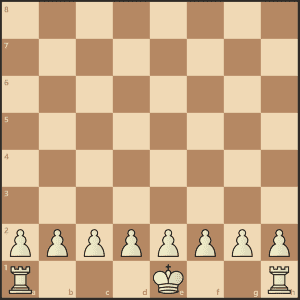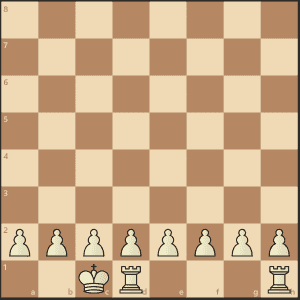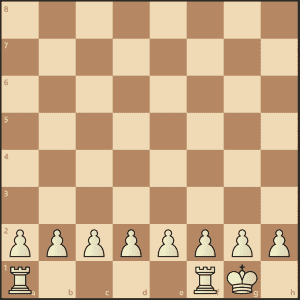Post content:
Castling
Although Develop parts It is a concept usually more important than castling, in fact the latter is so simple that it is even more popular than piece development.
What is Castling?
Castling is the only chess move in which the movement of two pieces is contemplated: the king and one of the rooks. Furthermore, in this move the rook "jumps" over the king.
To be able to castle there are two conditions:
- That the king or the rook used for castling has not moved.
- Let there be no pieces between the king and that rook.

So, from the top position we can castle on both sides, assuming that neither the king nor any of the rooks have moved.


Because it is important?
When evaluating a chess position, several things must be taken into account. Perhaps three of the most important are:
- King's security.
- Material.
- Parts development.
Judicious castling greatly helps the king's safety and allows one of the rooks to develop, or at least facilitate it to come into play.
Furthermore, a very common way to take advantage of the fact that one of the kings has not castled is to eliminate the pawns from the center so that the rooks along with the rest of the pieces can coordinate against that king. Sometimes you will even have to consider sacrificing a piece so that the enemy king is not comfortable. That's how important it is to castle on time and at the right moment.
When to castle?
Usually leaving the king uncastling is not advisable; In fact, in most cases in which you can castle, this turns out to be the best move, unless you have a very strong tactical or positional blow, for the reasons mentioned above.
There is also the question of whether to castle long or castle short, and although short castling is used in most games because it is faster and a little safer, the truth is that long castling creates much more dynamic positions and helps you bring a tower to the center immediately. Sometimes it is a very promising idea to throw your pawns towards the opponent's king, as soon as he castles, and try to coordinate your long castling with a good attack.
Summary
Castling is a fundamental move in the rules of chess, since it protects your king and allows one of your rooks to approach the center of the board.
If the enemy king still does not castle when your king is already safe, the best moves are usually related to eliminating the pawns in the center of both sides, to begin taking advantage of your rival's weaknesses as soon as possible. On the other hand, if your king is the only one not yet castled, you will have to prevent the center from opening, or your most important piece will be exposed.
Here ends the explanation of «Castling in chess«.
Can return to index of these chess tips and concepts by clicking here.
